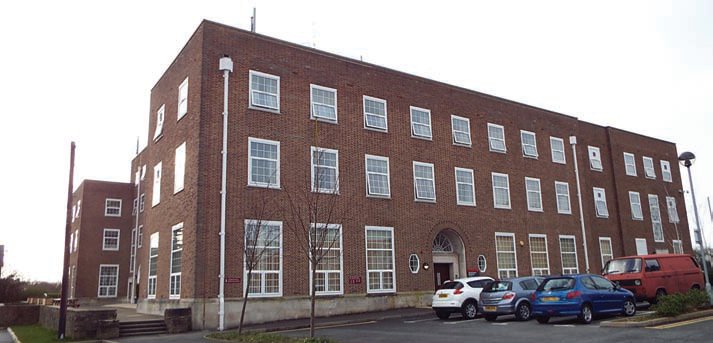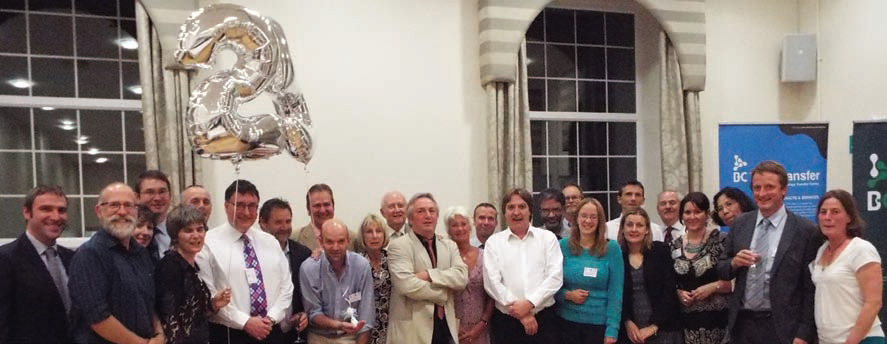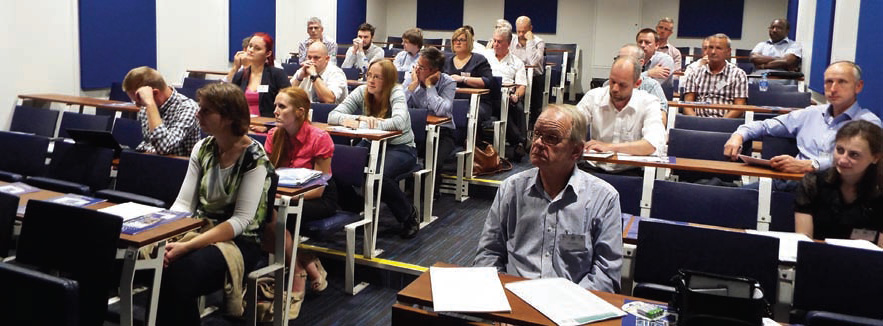A silver lining
27 January 2015The 25th anniversary of the BioComposites Centre was celebrated with an International Panel Products Symposium (IPPS) Master Class and Gala Dinner, held at Bangor University, North Wales, in September. Mike Botting was there to bring this report.
The BioComposites Centre was established in 1989, with the support of the Welsh Development Agency, in response to the need to develop better links between universities and industry. Now part of the College of Natural Sciences, it has a strategic role in linking research with industry at Bangor.
The European Panel Products Symposium (EPPS) was launched in 1997, later becoming the International Panel Products Symposium (IPPS) in 2007.
Originally EPPS was an annual event, with the symposium being held in Llandudno, a coastal resort with a modern conference centre a short distance from Bangor.
In recent years, it has become a biennial event in odd-numbered years and a Master Class has been held in the even-numbered years, such as 2014.
While the Symposium is open to all comers and takes the common format of presentations and table-top displays, the Master Class is designed to give informative talks together with practical, hands-on, exercises for the delegates. It is aimed at those people actively involved in the production or processing of panels and, due to its very nature, is designed for a smaller, more targeted audience.
The Master Class began with a presentation by Gus Verhaeghe, secretary general of InnovaWood, Belgium, on EU instruments and prospects ['prospectives'] for research and innovation in the wood based panel sector.
Mr Verhaeghe said that the European funding landscape had been very broad, with national programmes as well as pan-European initiatives.
Horizon 2020 grouped all European initiatives together into a more harmonised tool designed to strengthen the EU's global position in research, innovation and technology.
Mr Verhaeghe said there will be a €79bn investment in research and innovation during the seven years of Horizon 2020's activity (2014- 2020).
The three pillars of the programme are: Tackling societal challenges; creating industrial leadership and competitive frameworks; and excellence in the science base.
The last-mentioned includes Frontier research; future and emerging technologies; skills and career development; and research infrastructures. It accounts for €24.4bn of the total budget.
The programme includes a 'Forest-based sector technology platform' with the objectives of: Bringing all stakeholders together; identifying priorities to enforce competitiveness in the sector; and input towards Horizon 2020 work programmes.
The 'actors' are European industry federations (CEI Bois, CEPF, CEPI) and 25 member companies. It is to gather together companies, research entities and public bodies.
So-called 'Vision targets' for 2030 for wood products are: To triple the volume of wood as a building material, reaching a turnover of €200bn; to double the overall addedvalue of the woodworking industries; and to obtain increased value from new products and services, with more widespread use of energy-saving modular housing structures and functional furniture.
Innovawood is a member of the Task Force and Management Team for the forest-based sector Technology Platform (FTP) of Horizon 2020 and is leading the Woodworking Task Force. It reviews the Strategy Documents and organises FTP conferences, said Mr Verhaeghe.
It is also involved in the COST Action programme and is involved in several projects as a dissemination partner.
The next speaker was Dr Martin Ohlmeyer of the Thünen Institute of Wood Research, Germany. His subject was VOC emissions from wood products: a state-of-the-art report.
The Institute tests all kinds of wooden building materials. "There are different national requirements on VOC [volatile organic compounds] emissions in force in France, Belgium and Germany," said the speaker.
"Sensory testing is now in its pilot phase as part of ISO16000-28 but is subjective, being reliant on testing by using people's sense of smell. Time will tell whether this system will be introduced or not." Dr Ohlmeyer pointed out that this kind of test has reliability and repeatability issues.
Using OSB as an example, he said that the common VOCs are terpenes, saturated aldehydes, unsaturated aldehydes and acetic acid. MDF adds pentanal, hexanal, octanal, nonanal, 2-heptenal and 2-octanal.
He said that pinus sylvestris heartwood takes 100 days to fall below the acceptable threshold for VOCs, but the sapwood has a much lower concentration of VOCs and falls in a much shorter time - well under the 28 days which is stated in the standards. "To me this makes no sense."
Dr Ohlmeyer's "Take home messages" were: Discussion continues with respect to construction products regulation on an EU level; such regulation exists for some national markets; VOCs are a relevant issue for most organic material (including wood).
Delegates rounded off the first part of day one with a practical demonstration of micro chamber testing by Professor Ray Marriott and Ms Gee-Sian Leung, both of Bangor University.
Then they returned to the meeting room to hear Dr Adrian Higson, lead consultant for bio-based products, NNFCC, UK present Developing the bio-based economy: The Bio Base NWE project and IB catalyst funding. Dr Higson listed the various elements of the European bioeconomy as agriculture and fish, pulp & paper production and parts of the chemical, biotechnical and energy industries, as well as the wood based industries.
He talked about the cascading use of these materials, with heat and power being used at end of life of the material.
He noted that cellulose-based sugars are increasingly replacing food crop sugars in the production of ethanol.
The Beacon Centre in Wales is concerned in the process of producing products from plants and is a cooperation between Swansea, Aberystwyth and Bangor universities.
BioBase Europe has a pilot plant in Ghent, Belgium, and is Europe's most concentrated biobased energy sector. The pilot plant has testing and production facilities from laboratory to semi-industrial scale.
Concluding the first day's presentations, Dr Mark Lawther, Beaumaris Technologies Ltd and a former employee of BC, gave an overview of the history of the BioComposites Centre entitled Overview of research at BC: from early days into the future.
In 2005/6, BC moved its MDF pilot line and other large research facilities to its state of the art centre in Mona on the island of Anglesey, creating a subsidiary company BC Tech Transfer.
The BioComposites Centre is presently involved in three major EU-FP7 projects. He concluded by saying that BC today has funding from many sources, including the EU, the Welsh Government, the UK Government, as well as direct commercial income from research carried out on behalf of industry.
Next came the 25th anniversary Gala Dinner, during which Andrew Carpenter of the UK Structural Timber Association gave a speech in honour of BC's 25 years' service to the wood products industry.
Day two of the Master Class was opened by Dr Mark Irle, research director of Ecole Supérieure du Bois, France, whose subject was: EU regulations and market expectations on formaldehyde emissions and their potential impacts on the wood based panel sector.
He began by displaying a slide showing an advertisement in WBPI, placed by Hexion Speciality Chemicals, showing a woman with the legend: "On an average day, she will produce 1.5 ounces of formaldehyde; 16,000 times more than all the wood products in her home, combined". His point is obvious.
He also pointed out that formaldehyde is a naturally occurring substance and that the average human produces 40g per day. It is present in cigarette and wood smoke; vehicle emissions; textiles; and when food is cooked: "Everywhere!"
Dr Irle pointed out the current limits for wood based panels, which come under: EN717- 1 (all panel types); EN717-2 (plywood); EN120 (particleboard and fibreboard); Dessicator JIS A 1460 (F four star and three star) and CARB (particleboard and MDF).
"These limit are difficult to compare," he said, going on to outline how to obtain the French label for interior products.
He talked about REACH (Research, Evaluation, Authorisation, and restriction of Chemicals) and outlined a Formacare and EPF Risk Study.
Dr Irle went on to say that France has requested a reclassification of formaldehyde as category 1A and said that in December 2013, the Risk Assessment Committee of the European Chemical Agency (ECHA) recommended reclassification of formaldehyde to category 1B.
Dr Irle added that under LEED (Leadership in energy and environmental design), points are potentially lost if UF, MUF or PUF resin-bonded particleboards are used in a product.
Meanwhile, the US National Research Council concluded, in a review published in August 2014, that ".....formaldehyde is a known human carcinogen".
Again in August 2014, the European Chemicals Agency placed formaldehyde, when it is associated with oligomeric reaction products with aniline, on the 'authorisation list', with a deadline of 22nd February 2016. Dr Irle felt that it is only a matter of time before the same happens for formaldehyde in the resins used by the wood based panel industry.
The speaker said that the implication of the ECHA statement is that: "Those substances are progressively replaced by suitable alternative substances or technology where these are economically and technically viable".
In a conclusion based on his personal opinions, Dr Irle said: "Cancers seem to be limited to the preliminary respiratory tract. As formaldehyde is everywhere, I feel that cancer is probably linked to peak exposure, not a cumulative effect. Permissible formaldehyde levels are likely to be significantly reduced. Amine and amide based resins will eventually be phased out for wood based panel production."
Next, Dr Dirk Grunwald, technical manager, composite wood products, Huntsman, talked about Non-added-formaldehyde adhesives based on MDI. Huntsman's MDI adhesives are marketed under the trade name I-BOND.
The final presentation of the 2014 Master Class was given by Professor Callum Hill of JCH Industrial Ecology Ltd, UK and concerned LCA, EPD, PEF, BREEAM and LEED and he asked whether it was possible to compare the environmental performance of products.
Dr Elias and his team at the BioComposites Centre put together another varied and interesting technical programme for this Master Class and a very enjoyable 25th anniversary Gala Dinner. The agenda was tailored to panel manufacturers.
The next IPPS event will be held on October 7-8, 2015 in Llandudno.



